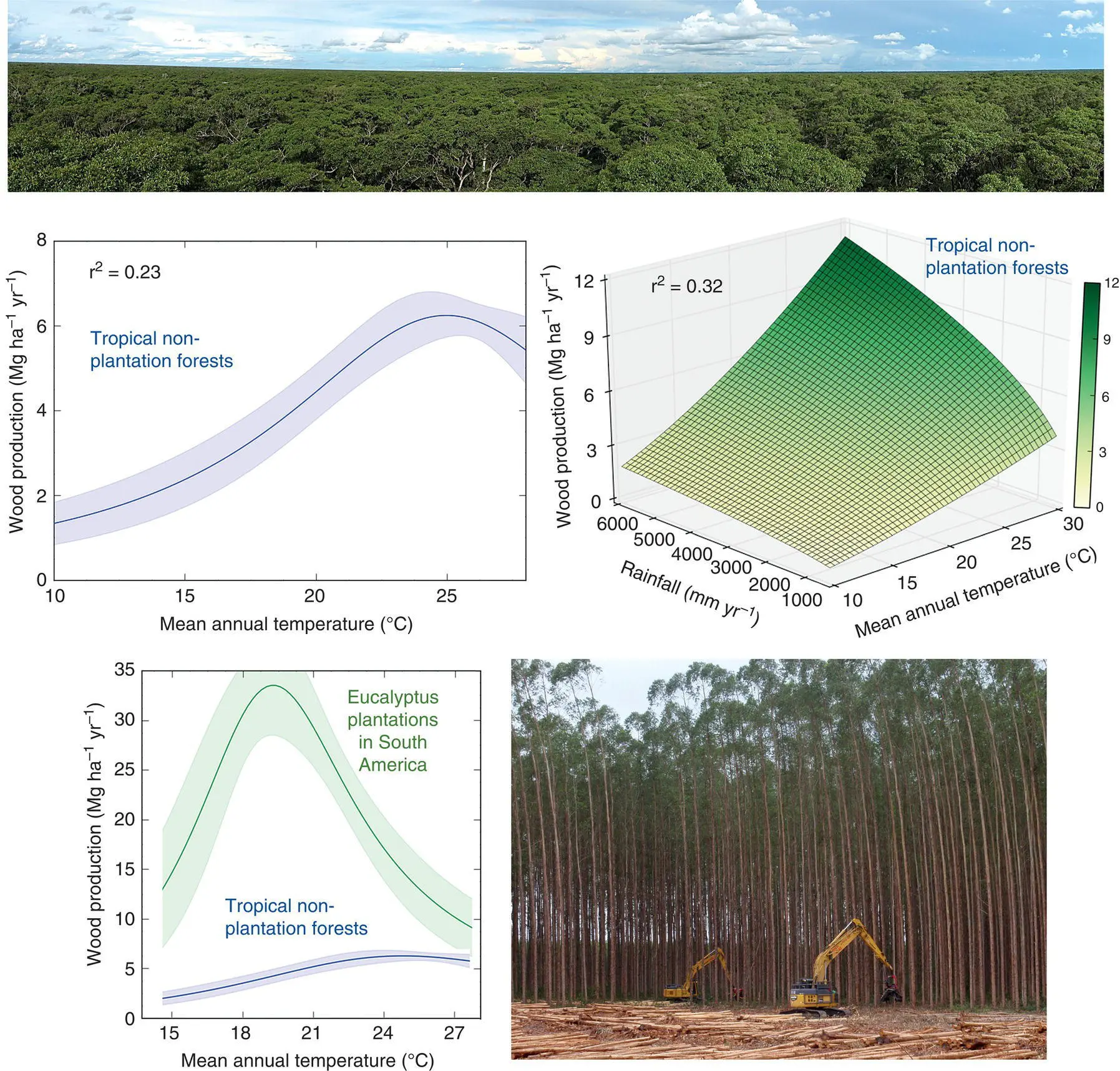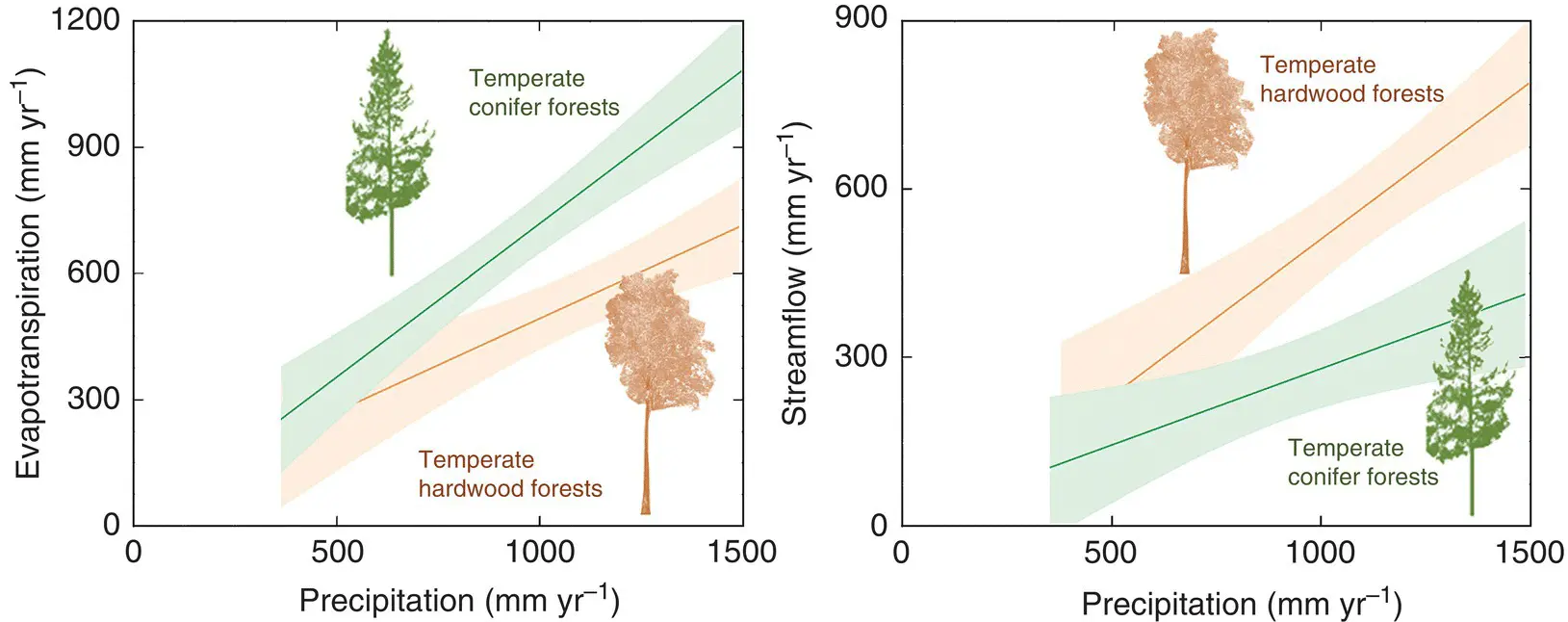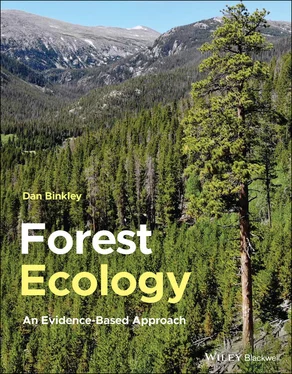Dan Binkley - Forest Ecology
Здесь есть возможность читать онлайн «Dan Binkley - Forest Ecology» — ознакомительный отрывок электронной книги совершенно бесплатно, а после прочтения отрывка купить полную версию. В некоторых случаях можно слушать аудио, скачать через торрент в формате fb2 и присутствует краткое содержание. Жанр: unrecognised, на английском языке. Описание произведения, (предисловие) а так же отзывы посетителей доступны на портале библиотеки ЛибКат.
- Название:Forest Ecology
- Автор:
- Жанр:
- Год:неизвестен
- ISBN:нет данных
- Рейтинг книги:5 / 5. Голосов: 1
-
Избранное:Добавить в избранное
- Отзывы:
-
Ваша оценка:
- 100
- 1
- 2
- 3
- 4
- 5
Forest Ecology: краткое содержание, описание и аннотация
Предлагаем к чтению аннотацию, описание, краткое содержание или предисловие (зависит от того, что написал сам автор книги «Forest Ecology»). Если вы не нашли необходимую информацию о книге — напишите в комментариях, мы постараемся отыскать её.
Forest Ecology
An Evidence-Based Approach Forest Ecology: An Evidence-Based Approach
Forest Ecology: An Evidence-Based Approach
Forest Ecology — читать онлайн ознакомительный отрывок
Ниже представлен текст книги, разбитый по страницам. Система сохранения места последней прочитанной страницы, позволяет с удобством читать онлайн бесплатно книгу «Forest Ecology», без необходимости каждый раз заново искать на чём Вы остановились. Поставьте закладку, и сможете в любой момент перейти на страницу, на которой закончили чтение.
Интервал:
Закладка:

FIGURE 2.18 The average growth of wood in tropical forests around the world increases with increasing temperatures (top left), but declines as average annual temperature exceeds 25 °C. Temperature accounts for 23% of the observed variations in wood growth, so other factors (such as rainfall, species composition, forest age, etc.) lead to situations that are well above and below the average trend. The combined effect of temperature and rainfall accounts for 32% of the of the variation among studies, so the importance of high rainfall appears to be higher on warmer sites (top right,
Source:Based on of Taylor et al. 2017, Cleveland 2017).
Intensively managed plantations of eucalyptus grow much faster than unmanaged tropical forests (bottom figures, plantation in picture is six years old), with an even stronger apparent influence of temperature.
Source:Based on Binkley et al. 2020.
The units used for precipitation and evapotranspiration are typically one‐dimensional (mm). The one‐dimensional number can be converted to volume with multiplication by an area (such as 1 m 2or 1 ha). This approach also works for streamflow; dividing the total amount of water transported in a stream by the land area of the contributing watershed gives a one‐dimensional measure (mm) of streamflow.
The rain and snow that fall on forests do not accumulate from one year to the next; the water either reenters the atmosphere or runs off into groundwater and streams. Evaporation in forests may be divided into three categories. Some water sitting at the surface of the soil may evaporate, but this evaporation is a small part of the water budget. Much larger fluxes are evaporation of water from the outer surfaces of leaves (canopy interception), and water from within leaves (transpiration). The sum of these three vectors is total evapotranspiration. Forest soils can retain several cm of water, but high intensity storms (and melting of snow) can exceed the soil's capacity to store water, leading to recharge of ground water and streams. Forest evapotranspiration accounts for virtually all the water falling onto forests in dry regions ( Figure 2.19). In some cases, riparian (streamside) forests use even more water than falls from the sky. Evapotranspiration in dry areas comes close to matching precipitation, leaving very little water for streamflow.

FIGURE 2.19 Forests occur in temperate regions where precipitation is typically greater than about 500 mm yr −1. Almost all the incoming precipitation is lost in evapotranspiration in drier regions (left), whereas streamflow accounts for almost as much water loss in wet regions. Conifers and broadleaves have similar evapotranspiration rates in dry areas, but conifers use more than broadleaves in wetter areas.
Source:Based on Ford et al. 2010.
A broadleaved forest in the Coweeta basin of North Carolina ( Chapter 1) received 2160 mm of rain in a year (Ford et al. 2010). Evaporation from the soil surface was minimal, as the top part of the soil O horizon was often dry. The evaporation of water from the outsides of canopy leaf surfaces (interception) was 145 mm (7% of precipitation), and of course most of this happened during the growing season because of the low surface area of trees without leaves in winter. Transpiration loss of water from within leaves summed to 200 mm yr −1(9% of precipitation), again mostly during the growing season. The sum of these losses (346 mm yr −1) accounted for 16% of precipitation, leaving 84% (1800 mm yr −1) to leave as streamflow.
Scientists at the Coweeta Hydrological Lab planted two entire watersheds with white pine trees to provide insights on water use by conifer forests versus native hardwood forests. The higher surface area of the pine needle canopy led to an interception loss of 280 mm yr −1(13% of precipitation), and transpiration of 420 mm yr −1(19% of precipitation), for a total evapotranspiration of 700 mm yr −1(30% of precipitation) and streamflow of 1460 mm yr −1.
Water Flows Down Gradients of Potential, Which Sometimes Means Going Up
The physics of water transport through soils and trees to evaporate into the air depends on water potential. Water potential can be thought of as a gradient, similar to a gradient in elevation. A drop of water sitting at rest in a puddle would have a low potential; it would not be possible to obtain work from movement of the water, and its potential could be defined as zero. But if the water could follow the gravitational gradient into the soil, that movement might have an opportunity to do work (though not much!). In this case, a potential for the water at the soil surface would be zero, and the potential of water deeper in the soil would be less than zero (a negative value). Movement along gradients goes from higher potential to lower potential, and zero is higher than negative numbers.
Water at the soil surface might move into the soil along a potential gradient that does not relate to gravity. A key feature of water molecules is an imbalance in electrical charge from one side of the molecule (slightly positive) to the other side (slightly negative). This polar aspect of water makes molecules line up with each other, providing surface tension to water drops. It also causes water to adsorb (stick) onto surfaces such as soil particles. Indeed, the potential for water being adsorbed onto surfaces of soil particles is very low (a large negative value), which means water in a puddle can be “sucked” into dry soil, faster than movement from gravity alone.
The sizes of mineral soil particles are important for influencing water infiltration into soil, movement through the soil, and storage between wetting events (see Chapter 6). The smallest particles are clay‐sized, meaning <2 μm. One gram of clay has more than 1 m 2of surface area to interact with water, so most water molecules are close enough to clay surfaces to slow their mobility. Water molecules that interact with surfaces have a lower (more negative) water potential than free water. The story of potentials also explains how water moves up trees, ascending tens of meters (or even one hundred meters) upward against the pull of gravity. Dry air has a tremendously negative potential compared to the insides of leaves, so water is sucked from leaves into the air, driving a potential gradient that goes against the gradient provided by gravity ( Chapter 4).
Wind Shapes Trees and Forests
Forests have a complex relationship with wind. For example, wind moving past a leaf cools the leaf in two interacting ways. Leaves have a “boundary layer” of air that restricts the exchange of energy, water and CO 2with the atmosphere at large. Winds strip away the outer portion of the boundary layer, making it thinner and facilitating more transfer of energy and matter. How much does this matter? A leaf exposed to sunshine with no wind might have a temperature about 3–5 °C cooler in a breeze than in still air (as noted earlier in this chapter). If the tree is well supplied with water and the air's vapor pressure deficit is not a problem, the leaf would be another 3 or 4 °C cooler, for a total temperature difference of about 7 °C (Knoerr and Gay 1965). This difference in temperature in relation to wind (with interacting effects on transpiration) would be large enough to change photosynthesis and respiration in a leaf by 10–50% ( Figure 2.4).
Читать дальшеИнтервал:
Закладка:
Похожие книги на «Forest Ecology»
Представляем Вашему вниманию похожие книги на «Forest Ecology» списком для выбора. Мы отобрали схожую по названию и смыслу литературу в надежде предоставить читателям больше вариантов отыскать новые, интересные, ещё непрочитанные произведения.
Обсуждение, отзывы о книге «Forest Ecology» и просто собственные мнения читателей. Оставьте ваши комментарии, напишите, что Вы думаете о произведении, его смысле или главных героях. Укажите что конкретно понравилось, а что нет, и почему Вы так считаете.












